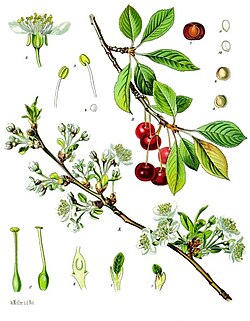| True cherries | |
|---|---|
 | |
| Illustration of Prunus cerasus | |
| Scientific classification | |
| Kingdom: | Plantae |
| Clade: | Tracheophytes |
| Clade: | Angiosperms |
| Clade: | Eudicots |
| Clade: | Rosids |
| Order: | Rosales |
| Family: | Rosaceae |
| Genus: | Prunus |
| Subgenus: | Prunus subg. Cerasus (Mill.) A.Gray, 1856 |
| Species | |
See text | |
Prunus subg. Cerasus is a subgenus of Prunus , commonly known as the true cherries. Species of the subgenus have a single winter bud per axil. [1] [note 1] The flowers are usually in small corymbs or umbels of several together (occasionally solitary, e.g. P. serrula), but some species have short racemes (e.g. P. maacki ). The fruit is a drupe and has no obvious groove along the side. [1] The subgenus is native to the temperate regions of the Northern Hemisphere, with two species in North America ( P. emarginata and P. pensylvanica ), four in Europe ( P. avium , P. cerasus , P. fruticosa and P. mahaleb ), two in North Africa (P. avium and P. mahaleb), and the remainder in Asia.
Contents
The fresh fruits of sweet cherry (worldwide) and Chinese cherry (in China) are consumed raw. The fruits of some species such as sour cherry are used to make desserts, sauce, jam and wine. The seeds of mahaleb cherry are used to make mahleb. Many species are cultivated as an ornamental tree, known as cherry blossoms.